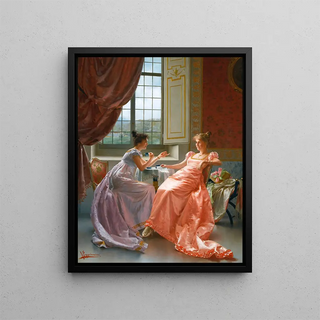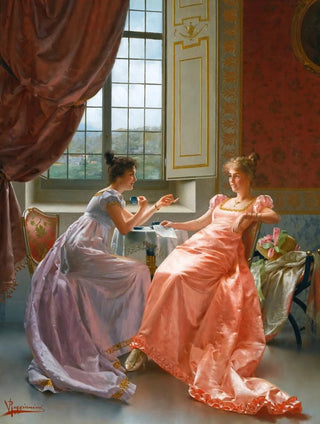Art print | An amusing letter - Vittorio Reggianini


View from behind

Frame (optional)
In the vast panorama of art, some works manage to capture the spirit of an era while evoking timeless emotions. "A Funny Letter" by Vittorio Reggianini is one of those creations that, beyond its apparent lightness, reveals a narrative depth and finesse of execution. This piece, which seems to freeze a moment of complicity between its characters, invites the viewer to dive into a world where everyday life blends with art. The artist, through his talent, transforms a simple epistolary exchange into a vibrant scene full of life and charm.
Style and uniqueness of the work
Reggianini's work is distinguished by its refined style and meticulous attention to detail. Every element of the composition, from facial expressions to the draping of clothing, is carefully crafted to create an atmosphere that is both lively and melancholic. The color palette used is subtle, oscillating between warm tones and softer shades, which enhances the intimacy of the scene. The play of light, in particular, highlights the features of the characters and the textures of the materials, giving the whole an almost tactile dimension. This ability to combine realism and idealization is a major characteristic of Reggianini's art, which succeeds in bringing to life seemingly mundane moments while elevating them to the level of art.
The artist and his influence
Vittorio Reggianini, born in Italy at the end of the 19th century, is often associated with the academic movement that favors realism and aestheticism. His work, although rooted in his time, transcends the limits of time and space, touching on universal themes such as love, nostalgia, and beauty. Reggianini was able to draw inspiration from the masters of the past while forging a personal style that is uniquely his own. His ability to capture daily life with such delicacy and elegance has influenced many artists of his era and continues to inspire future generations. Through his paintings, he tells us stories, immersing us in narratives that resonate with our own experience.

Matte finish

View from behind

Frame (optional)
In the vast panorama of art, some works manage to capture the spirit of an era while evoking timeless emotions. "A Funny Letter" by Vittorio Reggianini is one of those creations that, beyond its apparent lightness, reveals a narrative depth and finesse of execution. This piece, which seems to freeze a moment of complicity between its characters, invites the viewer to dive into a world where everyday life blends with art. The artist, through his talent, transforms a simple epistolary exchange into a vibrant scene full of life and charm.
Style and uniqueness of the work
Reggianini's work is distinguished by its refined style and meticulous attention to detail. Every element of the composition, from facial expressions to the draping of clothing, is carefully crafted to create an atmosphere that is both lively and melancholic. The color palette used is subtle, oscillating between warm tones and softer shades, which enhances the intimacy of the scene. The play of light, in particular, highlights the features of the characters and the textures of the materials, giving the whole an almost tactile dimension. This ability to combine realism and idealization is a major characteristic of Reggianini's art, which succeeds in bringing to life seemingly mundane moments while elevating them to the level of art.
The artist and his influence
Vittorio Reggianini, born in Italy at the end of the 19th century, is often associated with the academic movement that favors realism and aestheticism. His work, although rooted in his time, transcends the limits of time and space, touching on universal themes such as love, nostalgia, and beauty. Reggianini was able to draw inspiration from the masters of the past while forging a personal style that is uniquely his own. His ability to capture daily life with such delicacy and elegance has influenced many artists of his era and continues to inspire future generations. Through his paintings, he tells us stories, immersing us in narratives that resonate with our own experience.






